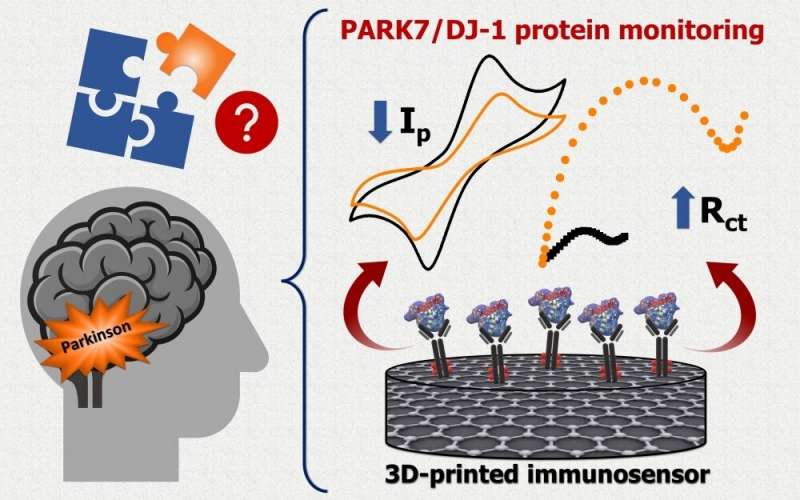This article has been reviewed according to Science X's editorial process and policies. Editors have highlighted the following attributes while ensuring the content's credibility:
fact-checked
trusted source
proofread
Low-cost sensor detects early-stage Parkinson's disease in biological samples

Researchers at the University of Campinas (UNICAMP) and the Federal University of São Carlos (UFSCar) in Brazil have developed an electrochemical sensor that detects Parkinson's disease at different stages. The device was fabricated using an ordinary 3D printer and proved capable of early diagnosis, also serving as a model for the identification of other diseases, according to an article published in the journal Sensors and Actuators B: Chemical.
"The sensor rapidly indicates the level of the protein PARK7/DJ-1 in human blood and synthetic cerebrospinal fluid. The molecule is associated with Parkinson's at levels below 40 micrograms per liter [40 μg/L]," said Cristiane Kalinke, first author of the article.
Kalinke is a postdoctoral fellow at UNICAMP's Institute of Chemistry (IQ) and a visiting researcher at Manchester Metropolitan University in the United Kingdom.
"It can be printed in various shapes and sizes. It can also be miniaturized to create a genuinely portable device that requires a very small sample," she explained.
To build the sensor, the researchers used a commercial filament made basically of polylactic acid (PLA), a biodegradable polymer, associated with a conductive material (graphene) and other additives. Three electrodes printed on the plastic substrate by additive manufacturing were chemically treated to make them more conductive and stimulate formation of a surface layer of functional groups (carboxyls) that bind to antibodies.
The activation process entailed removal of the polymeric insulating surface from the electrodes by immersion in sodium hydroxide (NaOH) and application of an electric potential (positive and negative). A reaction was then promoted between antibodies and PARK7/DJ-1 to produce a diagnosis.
Specific antibodies for PARK7/DJ-1 were immobilized on the surface of the electrodes, and the sensor was used to detect the protein at three levels: 30 μg/L, 40 μg/L and 100 μg/L. The average level in patients diagnosed with Parkinson's at different stages is approximately 30 ± 9 μg/L, according to data in the scientific literature.
"Patients are highly unlikely to go to see a doctor for a routine exam to detect early-stage Parkinson's. If onset of the disease is suspected, physical and behavioral symptoms have probably appeared, and the disease is probably already well-established," said Juliano Alves Bonacin, last author of the article and a professor in the Department of Inorganic Chemistry at IQ-UNICAMP.
"We decided to design and produce a very simple device that was cheap and could be used for continual monitoring, with alerts for physicians and patients if there were alterations in the level of PARK7/DJ-1, which is especially useful when analyzed in conjunction with other biomarkers."
Proof of concept
The study's primary significance is as proof of concept insofar as it demonstrated the versatility of 3D printing in producing a platform for the immobilization of biomolecules. "We succeeded in 3D printing all components of an electrochemical cell using only a polymer as the conductive material," Kalinke said. "In this specific study, commercially available materials were purchased off the shelf, but we're developing novel filaments for 3D printing in our lab as well."
According to the authors, the platform could be used to diagnose other diseases. In the specific case of PARK7/DJ-1, the protein is associated with type 2 diabetes, infertility and some cancers, as well as neurological disorders. The aim is to extend its use to other biomarkers, and Kalinke is working on a sensor to diagnose yellow fever.
"Imagine there's an outbreak of a certain disease in a particular area. With a few 3D printers and some electrodes, it would be possible to produce a sensor like ours on site," Bonacin said.
More information: Cristiane Kalinke et al, 3D-printed immunosensor for the diagnosis of Parkinson's disease, Sensors and Actuators B: Chemical (2023). DOI: 10.1016/j.snb.2023.133353



















